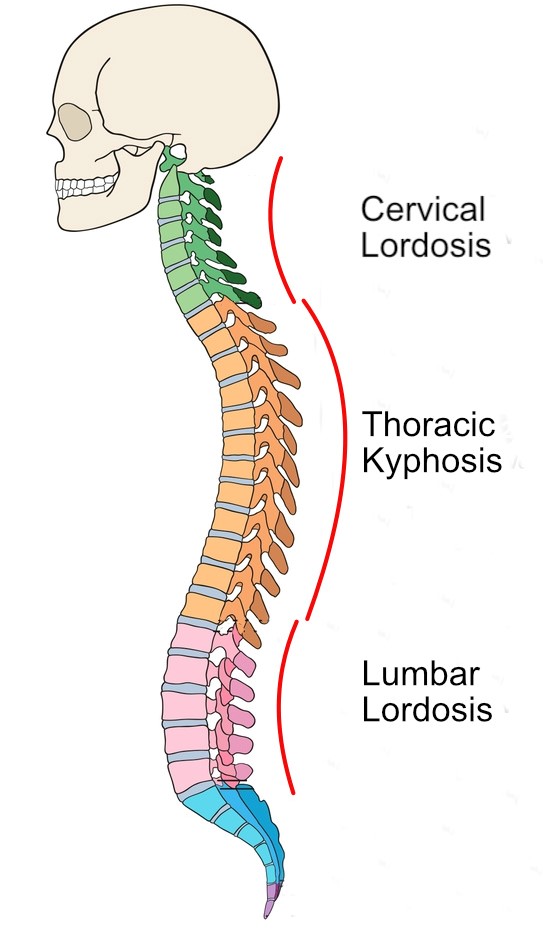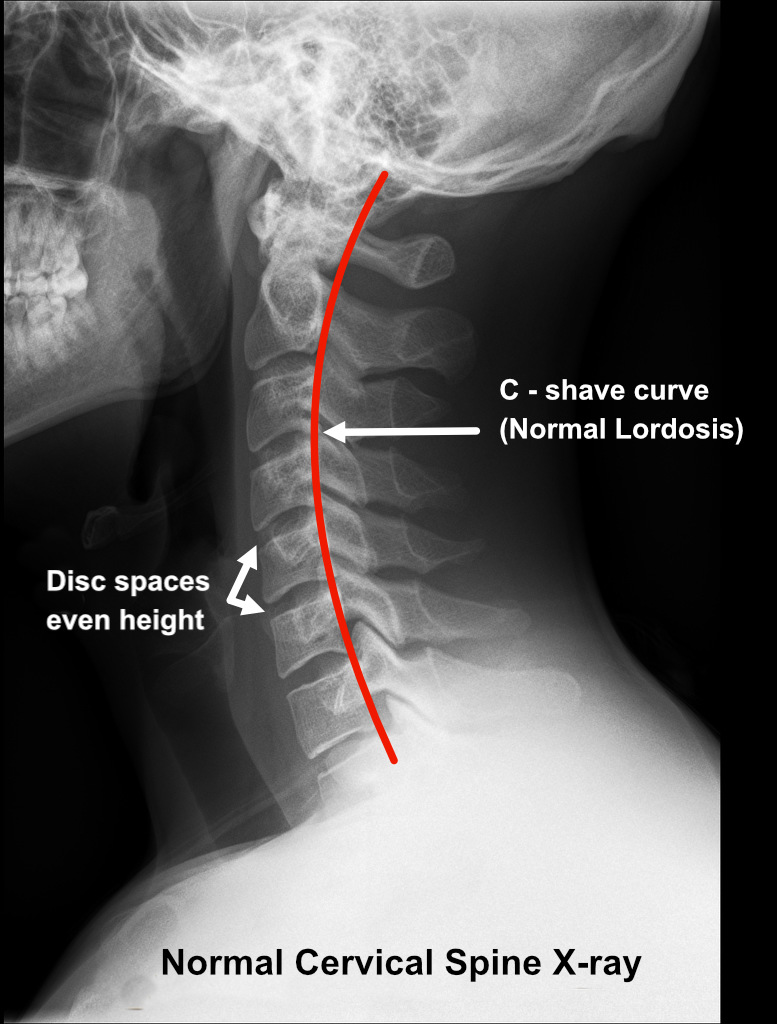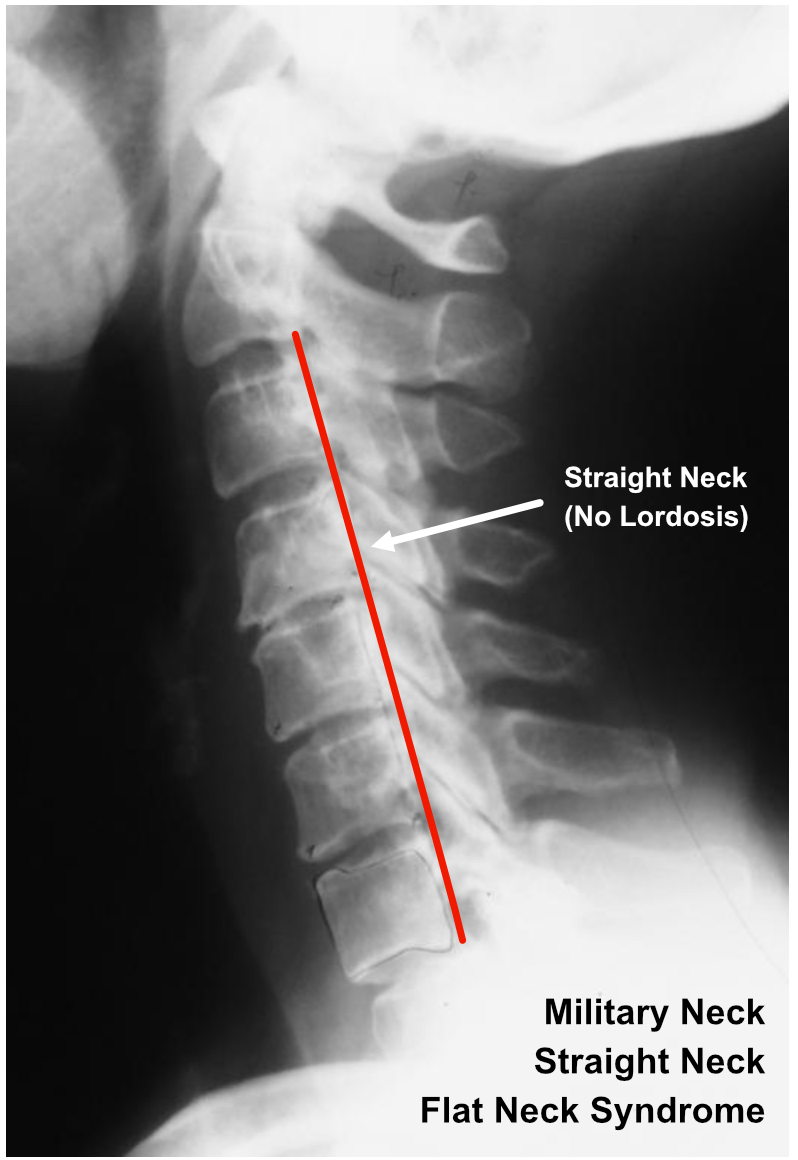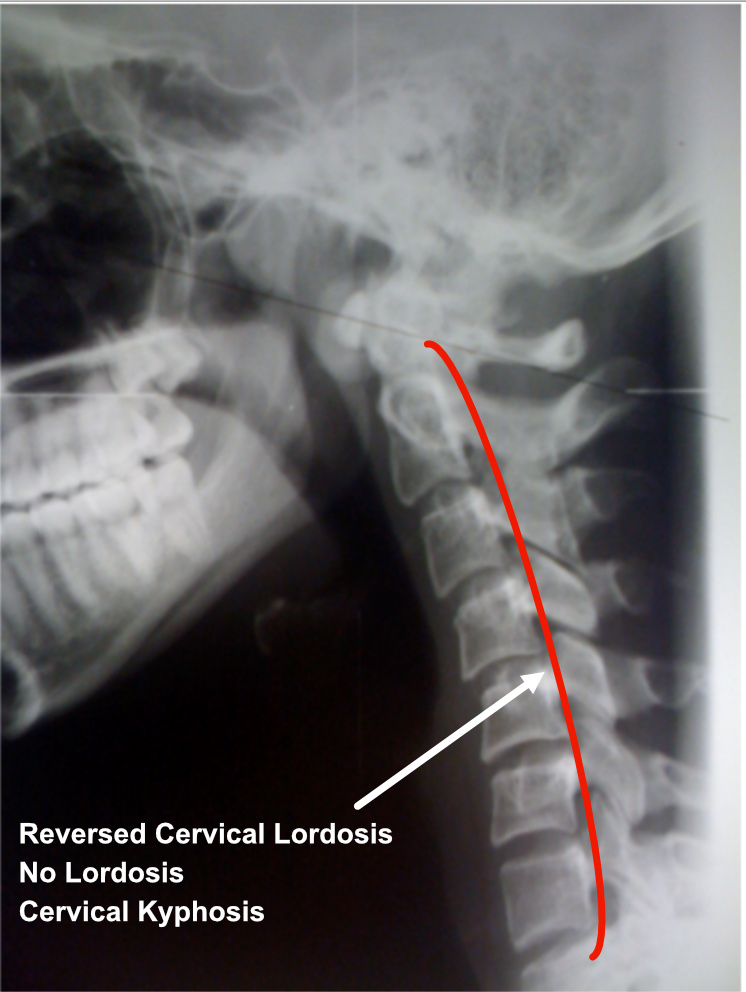
The spinal curve
A normal spine is S-shaped. This S-shape is created by three main curves, in the neck and lower back called ‘lordosis’, and in the dorsal or thoracic spine, ‘kyphosis’. These are healthy and necessary.
The curves function to:
- Absorb the shock, stresses and strains we place on the spine
- Support the weight of the head, which is around 5kg
- Balance the head on the neck and spine
- Help us to stand with minimal effort
- Create a frame to support the torso
- Allow attachments for muscles and ribs
- Allow flexibility and movement
- Protect the spinal cord and internal organs
Lordosis in the neck and lower back
The neck and lumbar lordosis (or lordotic curves) develop secondarily to the kyphosis and help humans to carry their weight over the pelvis and balance the head on the spine. This makes our walking gait far more energy efficient than the flexed-knees and waist-bent, leaning forward gait of other primates.
What causes the neck to straighten?
There are many factors that can cause the lordotic curve in the neck to straighten. For example, trauma to the neck such as whiplash injuries from car accidents can injure the neck.
Another very prominent factor is the poor posture encouraged by the use of handheld devices like smartphones and tablets. This is such a prevalent problem that the phenomenon has been named “text neck” – find more about the condition here.
Additionally, our increasingly sedentary lifestyles also contribute. Slouching or lying down crooked while using the laptop or watching TV forces the neck into an unnatural position.
Lastly, ageing, normal wear and tear, and old childhood injuries are also clearly factors that contribute to the neck’s natural curve being straightened.

Symptoms arising from “straight neck”
- Regular neck and upper back pain
- Headaches
- The head feels ‘too heavy’ on your neck
- The neck feels stiff – lack of movement, poor rotation, flexion and extension
- Decreased blood flow to the brain
- Increased pressure on the spinal discs, leading to wear and tear and arthritis
When the lordotic curve in the neck is straightened, the cervical spine can’t efficiently support the weight of the head, with loss of the counterbalance between the cervical curve (lordosis) and thoracic curve (kyphosis). This causes the neck to tighten and stiffen as the cervical muscles have increased work and are under more constant tension.
Cervical kyphosis or reversed curve syndrome
If there is further loss or instability in the cervical spine, then the straight or flat neck can progress into a reversed curve, or a cervical kyphosis, with potential further instability as shown on the X-ray.


Cervical lordosis or hyperlordosis
Increased cervical lordosis is very much less common than lumbar lordosis, where there are far greater compression and anterior pulling forces on the spine.
Dowager’s Hump
This is a hyperkyphosis of the Thoracic or Dorsal spine, a similar but reversed condition to flat neck syndrome. I write about this dowager’s hump in a separate article.
Can we regain our cervical lordosis?

In short, to a large extent no. It is not possible to dramatically alter the shape of the spine, or return the neck to the perfect textbook shape; nor would we want to. This is very important to understand. As with arthritis, it is not as simple as just removing the wear and tear and adjusting the spine back into shape.
The key factor is that our spines shape as we grow during childhood and will remain similar during our adult life, but with injuries, posture and repetitive strain the curve may be accentuated and worsen with the ageing process and wear and tear. We adapt and the spine adapts to its shape. Even if it were possible to somehow put the spine into ‘perfect alignment’, it would probably cause instability and almost certainly be a huge shock to the spine. The muscles and ligaments which have developed, tightened and shortened to adapt to our own shapes would all be out of alignment.
Think about this picture: trees don’t always grow straight. As they grow, they adapt to their own unique shapes. Provided the trunk and branches are flexible with tensile and ductile strength, the tree can live healthily.
Stability vs Instability
We need a stable spine! This means healthy joints moving freely without pain, and relaxed muscles to adapt to the stresses and strains of daily life. The crucial question is whether the spine and the shapes of the spine are stable.
Highly unstable spines may require medical treatment or surgical intervention to protect the spinal cord and nervous system in order to allow healing and the return of stability. However, there are many times when the curves in the spine are not in the extreme category of requiring medical treatment, but rather in the non-traumatic, chronic or recurring episodes of pain that may require some conservative treatment.
Spines need to be stable, responsive and adaptable
Our spines need to adapt to the curves they have developed to be stable, relaxed and balanced with pain-free movement to support us in our daily lives. Very few of us have ‘perfectly’ shaped spines and a perfectly shaped spine is not the Nirvana for treatment. If the spine is mis-shaped but pain-free the advice is simple, keep active and don’t worry!
Treatment goals – managing flat neck
The key aim of treatment is to prevent deterioration or worsening of the spinal curves. It is also to improve spinal function, within the available range of movement that we each have as individuals, that will in turn keep the spine pain-free and mobile.
More specifically, treatment aims to:
- Help the tight muscles around the spine to relax
- Reduce the compression forces on the neck
- Improve joint mobility to the locked or hypomobile joints
- Bring awareness of postural training to avoid undue pressure and stress on the spine
- Impart lifestyle training to avoid activities that can worsen or accentuate the misalignment
- Change the habit patterns that are aggravating the pain from the neck
Chiropractic treatment for flat neck or misaligned spinal curves
My view as an experienced Chiropractor is that Chiropractic treatment can help improve the mobility in the tight vertebrae, helping to maintain the movement, which in turn reduces pressure on the tight or injured areas and helps the spine to maintain its alignment. Clients often report that they feel their necks are not ‘pulling them down’ as much, and they can feel straighter and lighter. Chiropractic also helps to prevent deterioration of the spinal curves.
Prevent deterioration of flat neck, rather than cure
Above all, please don’t worry that this is a serious condition. It is one that helps us understand why your neck may give you problems and help guide the treatment.
We all have weak spines! We can all strain and injure ourselves with the stresses of modern life. The key is to understand that if our spines have altered alignment or wear and tear that these conditions are here to stay, but with care and attention we can usually keep our spines healthy, pain-free, flexible, balanced and relaxed. It’s true that for some of us, even if the shapes of our spines are not ‘perfect’, that maintaining health may require more work, care and attention than for others. This is a simple fact of life that we need to embrace and accept, just as we need to clean our teeth regularly and avoid the sugars to help prevent decay and lower our risk of cavities.